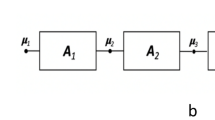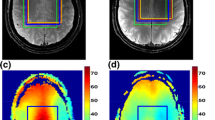Abstract
The homogeneity and stability of the static magnetic field are of paramount importance to the accuracy of MR procedures that are sensitive to phase errors and magnetic field inhomogeneity. It is shown that intense gradient utilization in clinical horizontal-bore superconducting MR scanners of three different vendors results in main magnetic fields that vary on a long time scale both spatially and temporally by amounts of order 0.8–2.5 ppm. The observed spatial changes have linear and quadratic variations that are strongest along the z direction. It is shown that the effect of such variations is of sufficient magnitude to completely obfuscate thermal phase shifts measured by proton-resonance frequency-shift MR thermometry and certainly affect accuracy. In addition, field variations cause signal loss and line-broadening in MR spectroscopy, as exemplified by a fourfold line-broadening of metabolites over the course of a 45 min human brain study. The field variations are consistent with resistive heating of the magnet structures. It is concluded that correction strategies are required to compensate for these spatial and temporal field drifts for phase-sensitive MR protocols. It is demonstrated that serial field mapping and phased difference imaging correction protocols can substantially compensate for the drift effects observed in the MR thermometry and spectroscopy experiments.
Similar content being viewed by others
References
Barkauskas KJ, Lewin JS, Duerk JL (2003) Variation correction algorithm: analysis of phase suppression and thermal profile fidelity for proton resonance frequency magnetic resonance thermometry at 0.2 T. J Magn Reson Imaging 17(2):227–240
Peters RD, Hinks RS, Henkelman RM (1998) Ex vivo tissue-type independence in proton-resonance frequency shift MR thermometry. Magn Reson Med 40(3):454–459
Henry PG, van de Moortele PF, Giacomini E, Nauerth A, Bloch G (1999) Field-frequency locked in vivo proton MRS on a whole-body spectrometer. Magn Reson Med 42(4):636–642
De Poorter J (1995) Noninvasive MRI thermometry with the proton resonance frequency method: study of susceptibility effects. Magn Reson Med 34(3):359–367
Haacke EM, Brown RW, Thompson M, Venkatesan R (1999) Magnetic resonance imaging: Principles and sequence design. Wiley, New York, pp.746–760
Kadah YM, Hu X (1997) Simulated phase evolution rewinding (SPHERE): a technique for reducing B0 inhomogeneity effects in MR images. Magn Reson Med 38(4):615–627
Ishihara Y, Calderon A, Watanabe H, Okamoto K, Suzuki Y, Kuroda K, Suzuki Y (1995) A precise and fast temperature mapping using water proton chemical shift. Magn Reson Med 34(6):814–823
Irarrazabal P, Meyer CH, Nishimura DG, Macovski A (1996) Inhomogeneity correction using an estimated linear field map. Magn Reson Med 35(2):278–282
Quesson B, de Zwart JA, Moonen CT (2000) Magnetic resonance temperature imaging for guidance of thermotherapy. J Magn Reson Imaging 12(4):525–533
Peters RD, Henkelman RM (2000) Proton-resonance frequency shift MR thermometry is affected by changes in the electrical conductivity of tissue. Magn Reson Med 43(1):62–71
Kanayama S, Kuhara S, Satoh K (1996) In vivo rapid magnetic field measurement and shimming using single scan differential phase mapping. Magn Reson Med 36(4):637–642
David F, Yerucham S; InSightec—TxSonics Ltd. (Tirat Carmel, IL) assignee (2003) MRI-based temperature mapping with error compensation. USA Patent 6,559,644. 6, May 2003
Bottomley PA (1987) Spatial localization in NMR spectroscopy in vivo. Ann N Y Acad Sci 508:333–348
Schar M, Kozerke S, Fischer SE, Boesiger P (2004) Cardiac SSFP imaging at 3 Tesla. Magn Reson Med 51(4):799–806
Gabr RE, Sathyanarayana S, Schär M, Weiss RG, Bottomley PA (2006) On restoring motion-induced signal loss in single-voxel magnetic resonance spectra. Magn Reson Med 56(4):757–760
de Zwart JA, Vimeux FC, Delalande C, Canioni P, Moonen CT (1999) Fast lipid-suppressed MR temperature mapping with echo-shifted gradient-echo imaging and spectral–spatial excitation. Magn Reson Med 42(1):53–59
Rieke V, Vigen KK, Sommer G, Daniel BL, Pauly JM, Butts K (2004) Referenceless PRF shift thermometry. Magn Reson Med 51(6):1223–1231
Silva AC, Merkle H (2003) Hardware considerations for functional magnetic resonance imaging. Conc Magn Res 16A(1):35–49
Foerster BU, Tomasi D, Caparelli EC (2005) Magnetic field shift due to mechanical vibration in functional magnetic resonance imaging. Magn Reson Med 54(5):1261–1267
Emeric PR, Hedlund CR; GE Electric Company, Schenectady, NY (US), assignee (2006). Method and system to regulate cooling of a medical imaging device. US patent 6,992,483 B1, 31 January 2006
Clarke N, Sellers MB, Allford ML, Mantone A; GE Electric Company, Schenectady, NY (US), assignee (2006) Apparatus for active cooling of an MRI patient bore in cylindrical MRI systems. US Patent 7,015,692. 21 March 2006
Gebhardt M, Gebhardt N, Schuster J; Siemens Aktiengesellschaft, Munich (DE), assignee (2005) Magnetic resonance apparatus and carrier device equipable with shim elements. US Patent 6,867,592. 15 Mar 2005
Author information
Authors and Affiliations
Corresponding author
Rights and permissions
About this article
Cite this article
El-Sharkawy, A.M., Schär, M., Bottomley, P.A. et al. Monitoring and correcting spatio-temporal variations of the MR scanner’s static magnetic field. Magn Reson Mater Phy 19, 223–236 (2006). https://doi.org/10.1007/s10334-006-0050-2
Received:
Revised:
Accepted:
Published:
Issue Date:
DOI: https://doi.org/10.1007/s10334-006-0050-2




